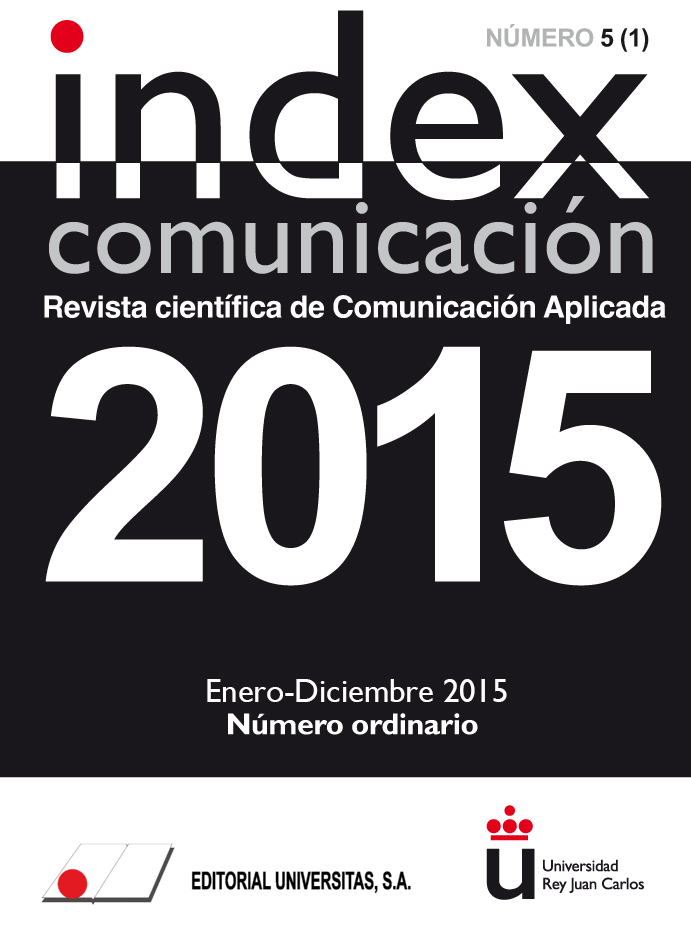Radio in the digital age. Case study: COPE programs created to be consumed exclusively online
Keywords:
Radio a la carta, COPE, redes sociales, podcasting, streaming, audiencia proactivaAbstract
Technological advancement has brought more developed, agile and powerful mobile devices along with the emergence of 4G and optical cable have been the perfect crop for podcasting, which has brought new forms of radio consumption and develop proactive consumers. Consequently, broadcasters have created a kind of programs that have not been issued through the waves and is now housed in the websites of the main Spanish chains. The most committed to this new form of broadcasting is the COPE and undergoing case study. They are analyzed through quantitative and qualitative methods: two emissions of each of the 16 programs. The results indicated that are downloadable and are issued only through the Internet, that its duration is variable being the most used all sorts of information and opinion, the content is different from traditional radio, which feature although most advertising self-promotion, and finally all of them have Facebook pages and Twitter; on the other hand, they are preferred by listeners, share links to programs and say about them.Metrics
References
Bonet, M. (2007): ‘Nuevos caminos para la radio. Un proceso productivo digital para un negocio analógico’, en Revista Telos: Cuadernos de comunicación e innovación, (73), pp. 27-35. Disponible en Internet en: http://telos.fundaciontelefonica.com/telos/articuloperspectiva.asp@idarticulo=1&rev=73.htm
Bustamante, E. (2008): ‘Hacia un nuevo sistema mundial de comunicación: Las industrias culturales en la era digital’. Editorial GEDISA. Disponible en Internet en: https://goo.gl/KAtoUS
Herrera Damas, S., (2003): ‘Tipología de la participación de los oyentes en los programas de radio’, en Análisis: Quaderns De Comunicació i Cultura, pp. 145-166. Disponible desde: http://www.raco.cat/index.php/analisi/article/viewFile/15142/14983
Herrero Gutiérrez, F. J. (2011a): ‘Los programas deportivos de la radio española en la red social Facebook: Espacio de promoción, lugar de encuentro ¿medidor de audiencia?’, en Área Abierta, (28), 3-3. Disponible en Internet en: http://revistas.ucm.es/index.php/ARAB/article/view/ARAB1111130003A/4028
Herrero, Gutiérrez, F. J. (2011b): ‘La nueva era radiofónica con programas emitidos exclusivamente online. Estudio de caso: los programas deportivos en las emisoras Ser y Cope’, en Sierra-Sánchez, Javier (2011): La tecnología audiovisual al servicio de la sociedad. Madrid: Fragua, pp. 105-119.
Herrero Gutiérrez, F. J. y Romero Bejarano, H. J. (2011): ‘Formatos publicitarios en la radio deportiva: de la tradicional cuña publicitaria a la importancia de la figura del animador’, en Pensar La Publicidad. Revista Internacional De Investigaciones Publicitarias, 5 (2), pp. 233-254. Disponible en Internet en: http://revistas.ucm.es/index.php/PEPU/article/view/37871/36639
Igartua Perosanz, J. J. (2006): Métodos cuantitativos de investigación en comunicación. Barcelona, Bosch.
Jordá, E. (2015): ‘La Radio 3.0: El Caso De Llosa FM’. Disponible en Internet en: https://riunet.upv.es/handle/10251/46611#
López, M. (2006): ‘La radio por Internet: La radio sin fronteras. Document Electrònic’, en Razón y Palabra, (49). Disponible en Internet en: internethttp://datateca.unad.edu.co/contenidos/401113/Guias_Produccion_de_Medios_Radio_2014_II/La_radio_por_internet.pdf
Página web de la Asociación para la Investigación de Medios de Comunicación. En línea desde: http:// http://www.aimc.es
Página web de COPE. En línea desde: http://www.cope.es
Página del Gobierno de Noruega. En línea desde: https://www.regjeringen.no/en/aktuelt/radio-digitisation-in-2017/id2406145
Pérez Dasilva, J.; Santos, M. T. S.; y Meso Ayerdi, K. (2015): ‘Radio y redes sociales: El caso de los programas deportivos en Twitter’, en Revista Latina De Comunicación Social, (70), pp. 141-155. Disponible en Internet en: http://www.ull.es/publicaciones/latina/070/paper/1039upv/09es.html
Ribes, X. (2002): ‘Edición y presentación multimedia. Fundamentos de la digitalización y del tratamiento de imágenes y sonido’. Disponible en Internet en: https://goo.gl/l5boCx
Rodero Antón, E. y Sánchez Serrano, Ch. (2007): ‘Radiografía de la radio en España’, en Revista Latina de Comunicación Social, 62. Recuperado el 18 de noviembre de 2015, desde: http://www.ull.es/publicaciones/latina/200714RoderoySanchez.htm
Rodilla, C. G. (2011): ‘Radios informativas online. Categorías metodológicas para su estudio y posterior aplicación a los casos de Radio Nacional y Radio Continental argentina’, en Razón y Palabra, (77), p. 33. Disponible en Internet en: http://www.razonypalabra.org.mx/varia/77%202a%20parte/21_Aviles_V77.pdf
Sobrino Ortiz, M. Á. (2012): ‘Radio y post-radio en España: Una cohabitación necesaria y posible’, en Área Abierta, (32). Disponible en Internet en: http://revistas.ucm.es/index.php/ARAB/article/viewFile/39637/38138
Vidales López, N. y Gómez Rubio, L. (2014): ‘La democratización del proceso comunicativo en radio: Los jóvenes prosumidores’, en Vivat Academia, (126), pp. 31-53. Disponible en Internet en: http://vivatacademia.net/index.php/vivat/article/view/552/92
Vídela Rodríguez, J. J. y Piñeiro-Otero, T. (2013): ‘La radio móvil en España. Tendencias actuales en las apps para dispositivos móviles’, en Palabra Clave, vol. 16, (1), pp. 129-153. Disponible en Internet desde: http://palabraclave.unisabana.edu.co/index.php/palabraclave/article/view/2579/3085
Downloads
Published
How to Cite
Issue
Section
License
Authors who submit to this journal agree to the following terms:
Authors retain copyright and ensure the magazine's right to be the first publication of the work as licensed under a Creative Commons Attribution-NoComercial 4.0 International License that allows others to share the work with an acknowledgment of authorship of the work and the initial publication in this magazine, with no commercial purpose.
Authors can establish separate additional agreements for non-exclusive distribution of the version of the work published in the magazine (for example, to an institutional repository or publish it in a book), with an acknowledgment of its initial publication in this journal.
It allows and authors are encouraged to disseminate their work electronically (eg, in institutional repositories or on their own website) prior to and during the submission process, as it can lead to productive exchanges, as well as a citation more early and most of the published work (See The Effect of Open Access).















